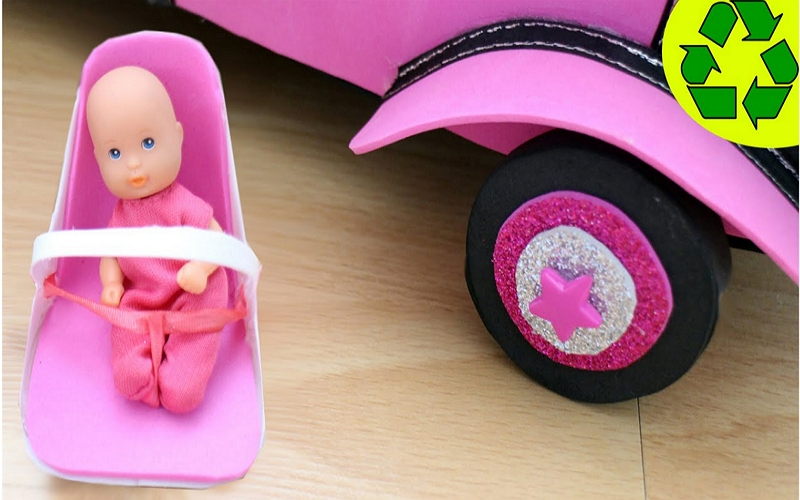In this article, you are going to learn How to make a baby doll car seat cover. The steps are easy and simple to follow.
What you need:

A car seat cover (you can get one at any baby store) A needle and thread or a sewing machine Fabric scissors Thread, needles, pins Ribbon Elastic cord Sewing meshing
Steps to follow:
Cut your fabric to the dimensions of your car seat (you will have an extra inch all around). Fold over your edges and sew them down. Sew a ribbon onto each side for decoration, if desired.
Cut small slits into the “basket” part where you would like elastic cord looped through. Thread one end of each piece of elastic cord into two opposite slits on either side so that they crisscross inside the basket.
Make sure it is tight enough so that the baby doll cannot escape, but not too tight as to damage or break needles!
Tie knots at both ends near the bottom outside corners.
Trim any excess off with scissors or rotary cutter/mat Set in place on top of car seat cover Use pins to secure edges to car seat cover (optional).
Should the baby seat go behind the driver or passenger?
Children are safer in the back seat, where rear-facing infant seats should be installed. But if your vehicle doesn’t have LATCH anchors for every seating position (or if you don’t want to use them), then it makes sense that the baby might ride behind either driver or passenger depending on space and what works best for the carseat installation.
If you do opt for this option, though, experts recommend keeping one of these two scenarios in mind: When putting a small child into an infant carrier—especially while buckling up after dark—it is much easier when they can see directly ahead because their face will catch more light than their feet or legs would.
This way parents won’t need to turn around so much and either break the child’s view or turn in ways that could be dangerous. However, when a toddler wants to sit behind their parent in a baby carrier (or if they need help seeing out because of poor eyesight).
It is easier for them to see directly back toward their caregiver; This way parents can talk with kids face-to-face while buckling up at night without having to twist around too much.
Can my 6-month-old go in a forward-facing car seat?
Yes, car seats are meant to save your child’s life and they can be used in the majority of cars. All forward-facing car seats will work for a child until he or she weighs 40lbs and is at least 32 inches tall (approximately four years old).
Car seat safety guidelines recommend that children stay in their rear-facing car seat as long as possible. So if you have an infant who fits this description then it is perfectly safe for her to remain in her rear-facing carseat while travelling by vehicle.
However, when she outgrows the height requirement on her current one but still does not weigh enough to switch into another model, consider buying a convertible seat with higher weight limits so that you do not need two different restraints while she is rear-facing.
Can my 6-month-old go in a forward-facing car seat?
The AAP recommends that babies are in a rear-facing car seat until they are at least two. All kids need to be in the backseat! That being said, if your child is over 20 pounds and/or is nearing 30 inches long, then you can start considering switching them into a forward-facing car seat like this one (Graco Snugride Click Connect 35).
The downside of transitioning too early? 80% of parents report their baby had head support when they switched from an infant carrier to a convertible or vice versa.
This risk might outweigh the benefits for some kids since it’s not recommended by experts like Safe Kids Worldwide. For other families, keeping their little ones all snugged in with a newborn head support system might keep them happier and safer for just a little longer.
How long do babies stay rear-facing?
The AAP recommends that children remain in a five-point harness facing rearwards until they reach the maximum height and weight limits of their car seat. These limits may be around age two or three, but it is important to check your child’s specific car seat for details on its use.
Once outgrown the rear-facing position by height and weight, toddlers can move into forward-facing convertible seats with harnesses (and tethers) before graduating to belt-positioning booster seats when old enough (age four through seven).
What is the next car seat after an infant?
Parents should carefully read their child’s car seat manual before using a booster. They need to ensure that the seat is designed for the height and weight of their growing child, otherwise, it can be dangerous.
Most experts recommend keeping your little one in an infant carrier until they are at least two years old or weigh about 20 lbs (which comes out to around nine months).
After this time period, you will probably want to move up into a forward-facing five-point harness carseat with higher top slots than an infant carrier offers. If possible, try not to turn your baby around too early – they still have very fragile necks and heads!
Once he/she weighs about 40lbs (again depending on size) then may graduate from a five-point harness to a booster seat.
